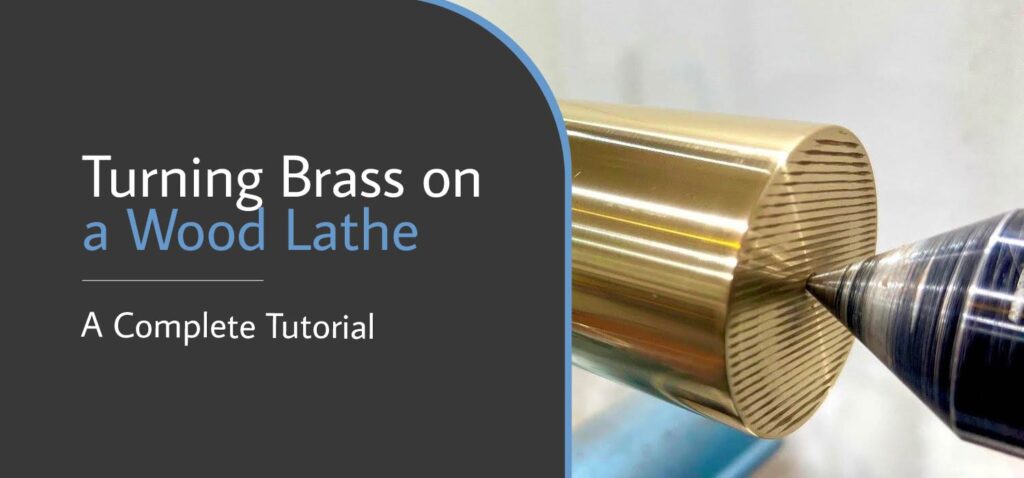Disclaimer: As an Amazon affiliate, I may earn a small percentage from qualifying purchases. This is at no extra cost to you. Learn more here.
Yes, I know that wood lathes are strictly for wood, and metal lathes are strictly for metal. But can an exception be made for turning brass on a wood lathe?
What if you just want to add a bit of metal flair to your woodworking projects, it should be fine to turn a softer metal like brass, right?
I’ll be covering whether or not you can turn brass on a wood lathe and how here.
Can You Turn Brass on a Wood Lathe?
If all you have is a wood lathe but you still want to turn brass, good news! You can, but with a few conditions.
First, remember that wood lathes aren’t designed to output the same amount of power as metal lathes, so don’t expect to turn any steel workpieces soon.
Next, don’t try turning any larger workpieces, because you’ll risk damaging your lathe, the workpiece and injuring yourself.
Materials You Will Need

I recommend picking up a few new tools and appliances before you try turning brass (or any soft metal) on your wood lathe. You want to avoid injury while turning!
Protective Gear
The biggest difference I’ve found between turning brass and wood is the shavings. You know this already, but wood shavings can be a huge pain.
Now imagine if the wood shavings were also red-hot. Ouch, right? Wear safety glasses or a face shield to keep any brass shavings away from your eyes while you’re turning.
The Center
A normal woodworking spindle won’t cut it when you turn brass. You’ll need a live center to keep your workpiece steady and keep it from jumping out of your hands.
This new center will also ensure your workpiece has adequate support in case you use the tailstock.
A New Chuck
Woodworking chucks are different from metalworking chucks, so I recommend getting an entirely new chuck for your brass. I suggest getting a four-jaw chuck for the versatility it offers, or a scroll chuck for quicker adjustments.
You need a chuck that can tightly grip your workpiece as you turn, so that chatter doesn’t mark your final product.
Tool Holder
There’s no need to risk your fingers just for your brass, so please don’t try to rely on a tool sled for turning brass! Instead, get a proper tool holder for more precision and a faster process.
High-Speed Steel
Don’t rely on your wood chisels to do the job; pick up some new high-speed steel (HSS) drill bits instead! HSS tools will help you machine more efficiently and provide the power to machine brass.
HSS drill bits are also more durable than most wood chisels.
Types of Brass You Can Turn

Here are the types of brass I’ve found are more workable.
Smaller Workpieces
If you have hardened brass that needs a slight polish, it’ll be easy to turn. Remember to keep a steady hand so that it doesn’t fly out during the process.
Soft Brass
This includes most pieces of brass since brass is usually soft. Just remember to set your lathe to turn slower so you don’t end up denting or breaking your workpiece.
How to Turn Brass on a Wood Lathe: Step-By-Step Process

1. Replace the Chuck
I mentioned getting a new chuck earlier, and this is where it comes in. Begin by replacing your woodworking chuck with a metal working one, for a better grip on your workpiece.
2. Install a New Center and Tool Holder
Now that your chuck’s sorted, next you’ll need that center and tool holder installed. Your center needs to handle a drill bit that can cut a center hole into your workpiece.
After your center’s installed, fasten your tool holder in place.
3. Lower the Speed
Before you start turning, set your lathe to a lower RPM to reduce the risk of chatter and for more efficient turning.
Your optimal speed will depend on the brass you’re cutting and the final shape you want, but I recommend going slower.
4. Cut the Workpiece
With your workpiece firmly gripped by the chuck, cut a center hole inside one end of the blank, then turn the machine off. Once it’s off, bring in the rest of the brass and cut it slowly.
Remember to center your cuts with the center hole, and avoid setting your tools against the workpiece head-on. Smooth and sand the workpiece, and you’re finished!
Frequently Asked Questions
Turn to this section if you have any more questions about turning brass (and other metals) on a wood lathe!
Can I Turn Copper on a Wood Lathe?
Yes, you can turn copper on a wood lathe! It’s a non-ferrous metal, just like brass, so it’s softer and fairly easy to turn. Remember to wear respiratory gear, so you don’t inhale any of the shavings.
Can You Turn Bronze on a Lathe?
You can also turn bronze instead of brass. Again, remember to stick to smaller workpieces and wear the right protective gear.
Why Is My Bronze Turning Green?
Bronze contains copper, which turns green when it oxidizes. This protective layer of oxidation is caused by air and water exposure.
Is Bronze More Machinable Than Brass?
Bronze is harder than brass, but it’s less machineable because it’s more brittle. I’d recommend machining brass instead because it’s more malleable but still fairly tough.
Conclusion
So there you have it, how to turn brass (and other soft metals) on a wood lathe!
Take care to reduce chatter while you’re turning, and remember that turning metal workpieces is different from turning wood.
Just be careful to stick to non-ferrous metals! Don’t move up to steel workpieces unless you plan to upgrade to a metal lathe.

